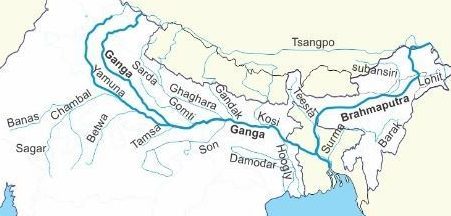Why in the News?
A recent study by researchers from IIT Gandhinagar and the University of Arizona warns that the Ganga River is drying at a rate unseen in more than a millennium.
About Drying of the Ganga River: New Study Findings
- Overview: Reconstructed streamflow since 700 AD using tree-ring records (Monsoon Asia Drought Atlas) and hydrological models. Validated against historic droughts and famines such as the Bengal famine.
-
Findings:
- Between 1991 and 2020, multiple droughts lasted 4–7 years, the rarest in the past 1,300 years.
- The 2004–2010 drought was the most severe in 1,300 years.
- Post-1990s drying was 76% more intense than the worst 16th-century drought.
-
Causes:
- Weaker monsoons from Indian Ocean warming and aerosol pollution.
- Groundwater over-extraction reducing river baseflow.
- Land-use change disrupting natural recharge.
- Climate Models: Most fail to reproduce the drying trend, raising doubts about optimistic rainfall projections.
- Implications: Severe threats to agriculture, 600 million livelihoods, Bay of Bengal ecosystems, and the 40% GDP share of the basin. Calls for adaptive water management.

About the Ganga River:
- Length: ~2,525 km, the longest river in India.
- Origin: Gangotri Glacier in Uttarakhand at 3,892 m elevation as Bhagirathi.
- Formation: Named Ganga at Devprayag after meeting Bhagirathi and Alaknanda.
- Course: Flows through Uttarakhand, Uttar Pradesh, Bihar, Jharkhand, West Bengal before entering Bangladesh as Padma and emptying into the Bay of Bengal through the Sundarbans Delta.
- Basin: Covers about 8.61 lakh sq. km, which is 26.4% of India’s area.
-
Tributaries:
-
- Left bank: Ramganga, Gomti, Ghaghara, Gandak, Burhi Gandak, Koshi, Mahananda.
- Right bank: Yamuna, Tons, Karamnasa, Sone, Punpun, Falgu, Kiul, Chandan, Ajoy, Damodar, Rupnarayan.
- Population: Supports over 600 million people, making it the world’s most densely populated river basin.
- Cultural Importance: Sacred in Indian culture; declared National River in 2008.
- Economic Role: Central to agriculture, fisheries, and trade, contributing about 40% of India’s GDP.
- Ecological Significance: Home to snow leopard, elephants, and Ganga dolphin; includes Corbett, Dudhwa, and Sundarbans reserves.
- Conservation Efforts: Ganga Action Plan (1985) and Namami Gange Programme (2014); persistent issues of pollution, over-extraction, and climate change.
| [UPSC 2024] With reference to the Himalayan rivers joining the Ganga downstream of Prayagraj from West to East, which one of the following sequences is correct?
Options: (a) Ghaghara – Gomati – Gandak – Kosi (b) Gomati – Ghaghara – Gandak – Kosi* (c) Ghaghara – Gomati – Kosi – Gandak (d) Gomati – Ghaghara – Kosi – Gandak |
Get an IAS/IPS ranker as your 1: 1 personal mentor for UPSC 2024

